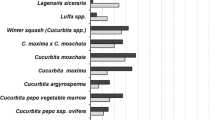Abstract
Two populations of Ixodia achillaeoides established from wild plants collected in the Adelaide Hills and the South East areas of South Australia were inoculated with Meloidogyne hapla, M. incognita and M. javanica, alone or in combination with Verticillium dahliae in greenhouse experiments. Both V. dahliae and Meloidogyne spp. infected these two I. achillaeoides populations and suppressed growth. However, symptoms of severe wilting and death that were previously reported in field specimens were not observed in greenhouse plants unless inoculated with both V. dahliae and Meloidogyne spp. Extensive discoloration of vascular tissue of the basal stem, associated with infection by V. dahliae, was also observed only in dying plants infected with both pathogens. These nematodes and the fungus form a disease complex in I. achillaeoides. The population of I. achillaeoides from the Adelaide Hills was significantly more resistant to M. javanica than to either M. incognita or M. hapla, while the population from the South East was significantly more resistant to M. hapla than to the other two species.
Similar content being viewed by others
References
Barker, K.R. (1993) — Resistance/tolerance and related concepts/terminology in plant nematology. Plant Disease 77: 111–113.
Corbett, D.C. and Hide, G.A. (1971) — Interactions between Heterodera rostochiensis Woll. and Verticillium dahliae Kleb. on potatoes and the effect of CCC on both. Annals of Applied Biology 68: 71–80.
Faulkner, L.R. and Skotland, C.B. (1965) — Interactions of Verticillium dahliae and Pratylenchus minyus in verticillium wilt of peppermint. Phytopathology 55: 583–586.
Hall, B.H., Jones, M.K., Wicks, T.J., Walker, G, and Barth, G. (1996) — First report of diseases of Ixodia achillaeoides in South Australia. Australasian Plant Pathology 25: 215.
Hussey, R.S. and Barker, K.R. (1973) — A comparison of methods of collecting inocula of Meloidogyne spp. including a new technique. Plant Disease Reporter 57: 1025–1028.
Mountain, W.B. and McKeen, C.D. (1962) — Interaction of Verticillium dahliae and Pratylenchus penetrans in tomato wilt. Phytopathology 52: 744.
Oostenbrink, M. (1966) — Major characteristics of the relation between nematodes and plants. Landbouwhogeschool Wageningen 66: 3–46.
Orlowsky, J.I., Powelson, M.L. and Ingham, R.E. (1988) — Relationship of Verticillium dahliae, Meloidogyne chitwoodi, and irrigation to potato early dying. American Potato Journal 65: 494.
Santamour, F.S. (1992) — Influence of root-knot nematodes on verticillium wilt of maple. Journal of Arboriculture 18: 298–301.
Scholte, K. and S’-Jacob, J.J. (1989) — Synergistic interactions between Rhizoctonia solani Kuhn, Verticillium dahliae Kleb., Meloidogyne spp. and Pratylenchus neglectus (Rensch) Chitwood & Oteifa, in potato. Potato Research 32: 387–395.
Sidhu, G.S. and Webster, J.M. (1981) — The genetics of plant-nematode parasitic systems. The Botanical Review 47: 387–419.
Snedecor, G.W. and Cochran, W.G. (1980). Statistical Methods 7th Ed. The Iowa State University Press: Ames.
Stanton, J.M. and O’Donnell, W.E. (1994) — Hatching, motility, and infectivity of root-knot nematode (Meloidogyne javanica) following exposure to sodium hypochlorite. Australian Journal of Experimental Agriculture 34: 105–108.
Stirling, G.R. and Wachtel, M.F. (1985) — Root-knot nematode (Meloidogyne hapla) on potato in southeastern South Australia. Australian Journal of Experimental Agriculture 25: 455–457.
Tarjan, A.C. (1972) — Observations on extracting citrus nematodes. Tylenchulus semipenetrans, from citrus roots. Plant Disease Reporter 56: 186–188.
Taylor, A.L. and Sasser, J.N. (1978) — Biology, identification and control of root-knot nematodes (Meloidogyne species). North Carolina State Graphics: Raleigh, North Carolina.
Whitehead, A.G. and Hemming, J.R. (1965) — A com parison of some quantitative methods of extracting small vermiform nematodes from soil, Annals of Applied Biology 55: 25–38.
Author information
Authors and Affiliations
Corresponding author
Rights and permissions
About this article
Cite this article
Walker, G.E. Effects of Meloidogyne spp. and Verticillium dahliae on the growth of two Ixodia achillaeoides populationson the growth of two Ixodia achillaeoides populations. Australasian Plant Pathology 29, 81–85 (2000). https://doi.org/10.1071/AP00015
Received:
Accepted:
Issue Date:
DOI: https://doi.org/10.1071/AP00015




